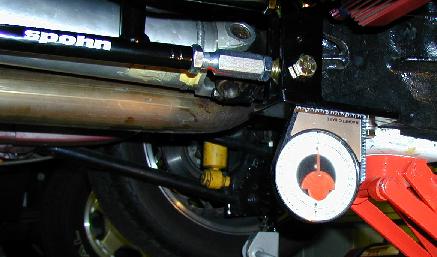![]()

You want to set your pinion angle, to make sure you know what it's at. I'm new at this part, but to my understanding, you want zero degrees for normal street driving or road racing. At the drag strip, you want -2° to -4° - I'm not clear on how you pick the actual angle, but comments generally seem to imply that more power will cause more TA and bushing flex, therefore you need more negative angle to compensate. Setting it is pretty easy. Make sure the car is supported by the rear axle, with weight loaded as it would be with the car on the ground (jacks under the axle, or tires on ramps).

Sketch of zero pinion angle - note driveshaft and rear are aligned

Sketch of negative pinion angle - note driveshaft and rear dip down
First, loosen the adjustment bolts appropriate for your torque arm. Measure your pinion angle with an angle finder, looking from the driver's side of the car, as follows:
Put angle finder on driveshaft, lining it up along the
very bottom. Read angle = DS°
Put angle finder along flat bracket along bottom of TA.
Read angle = PA°
Calculate TPA° = DS°-PA°
This value, TPA° is your pinion angle. It doesn't really matter what the actual value of DS° or TA° is, because they're dependent on the angle your car is currently jacked up to (or the angle of your floor or lift). The difference between them is the critical number. Crank the adjuster to shorten or lengthen the lower portion of the arm, to set the angle to whatever value you want to use, then tighten down the jam nuts and the two through the rod ends.
|
Copyright © 1997-2004 David Mills, no part of this site (http://www.go-fast.org/) may be reproduced without permission of the author. The author makes no claims or guarantees as to the quality of the information on this site. I'm an enthusiast just like you, and while everything here is correct as I know it, I'm not responsible if your car breaks. |













